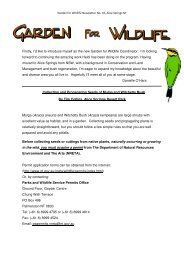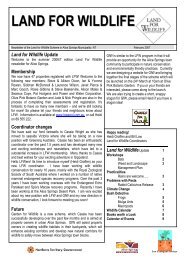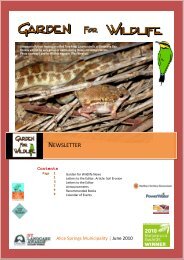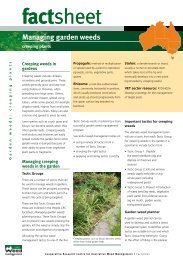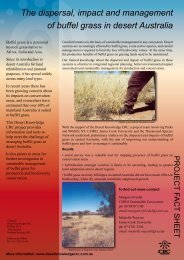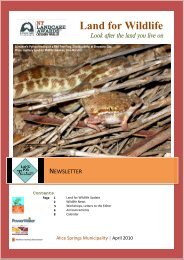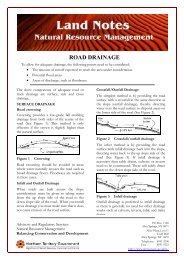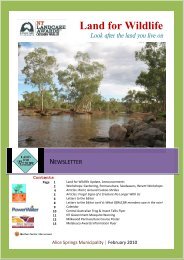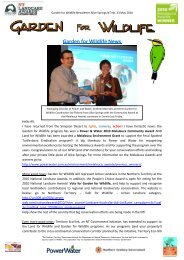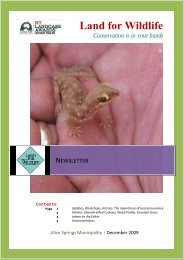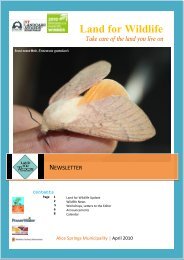Identifying Nests, Tracks, Scats, Burrows, & Other Signs
Identifying Nests, Tracks, Scats, Burrows, & Other Signs
Identifying Nests, Tracks, Scats, Burrows, & Other Signs
You also want an ePaper? Increase the reach of your titles
YUMPU automatically turns print PDFs into web optimized ePapers that Google loves.
<strong>Identifying</strong> <strong>Nests</strong>, <strong>Tracks</strong>, <strong>Scats</strong>, <strong>Burrows</strong>, & <strong>Other</strong><br />
<strong>Signs</strong><br />
All animals leave some sign of their presence and if you know how to see or read the country, then<br />
you can appreciate the presence of more species and monitor your efforts to improve habitat more<br />
effectively. There are many signs of life apart from tracks. However, tracks are most readily seen and<br />
interpreted. The best time to go tracking is early in the morning or late in the afternoon when the<br />
sun casts shadows across the ground. If you try to track at midday, the sun washes away any signs of<br />
prints, making tracks invisible to our eye. See below for some tips on identifying tracks, burrows,<br />
nests and other signs of life.<br />
Birds<br />
<strong>Nests</strong><br />
Above - Willie Wagtail: builds its nest from grass and woven spider web. The nest is lined with soft<br />
grass, fur or hair. The nest may be reused annually or deconstructed to provide materials for the<br />
new nest (see right image). The nest will be built on a horizontal branch or structure. The Willie<br />
Wagtail actively defends its territory, but will commonly and tolerantly nest in very close proximity<br />
to human habitation.<br />
Above - Babbler: Grey-crowed and White-browed Babblers live and breed in communal nests and<br />
have multiple decoy nests around the breeding area, perhaps because these colonial birds do<br />
practice nest building until it is their turn to establish a real nest with eggs in it. They are a social<br />
bird, living in groups of two to fifteen birds, and most members of the group will help to build nests<br />
and rob each others nests for building materials. A roosting nest (a much larger nest for resting and
used by the whole group) and a brood nest (for the breeding female) is built, usually in the fork of a<br />
tree 4-7metres high, and will be renovated and reused every year. <strong>Nests</strong> are built with sticks and are<br />
dome shaped with a hood and landing platform for the entrance tunnel.<br />
Above - Fairy-Wren: nests are an oval or round shaped dome, constructed of loosely woven grasses<br />
and spider web, with an entrance to one side. <strong>Nests</strong> are often placed in a low shrub close to the<br />
ground, well-concealed in thick and often thorny vegetation, such as species of Hakea.<br />
OR<br />
Small Honeyeater (e.g. White-plumed, Brown or Singing Honeyeater) – As the nest pictured does<br />
not have a side entrance, which Thornbill, Zebra finch and Fairy-Wren nests mostly do, it may be a<br />
small honeyeater nest. Male Honeyeaters defend a nesting territory by singing from tall trees during<br />
breeding season, and stand guard while the female builds the nest and lays the eggs. This nest was<br />
seen at the Brunonia Rd. property, where Singing and White-plumed Honeyeaters were observed<br />
during the surveys, and Mistletoe and Wild Passionfruit were flowering creating an abundant food<br />
source (diet consists of nectar and insects). The nest was inactive, but broken eggshell on the ground<br />
below suggests that the nest was occupied some time during the month before the surveys. Small<br />
Honeyeater nests are generally small cup-shaped constructions of fine bark, grasses and plant<br />
material, bound with spider’s web. They are slung by the rim in a shrub or tree, as the nest pictured<br />
appears to be, up to 5metres from the ground and are usually very well-hidden by thick foliage.<br />
Honeyeaters are quite aggressive defenders of territory and nesting sites. Their nests may come<br />
under predation from Pied Butcherbirds, snakes and cats. Pallid Cuckoos and Horsfield's Bronze-<br />
Cuckoos occur in the area (a Pallid Cuckoo was observed at Heffernan Rd. in proximity to Brunonia<br />
Rd.) and will parasitise nests.<br />
Above - Zebra Finch: build spherical nests from rough grass stalks and thorny twigs, lined with softer<br />
grass or feathers and wool. Nesting sites vary, but include bushes and trees and tree holes. In the<br />
Central Australia nests can be commonly found in Dead Finish. The entrance is on the side, which is<br />
protected by a short tube.<br />
OR
Thornbill: The Yellow-rumped Thornbills nest is a large and untidy structure of grass and bark. It has<br />
two parts: an upper 'false' cup-shaped nest and a lower, domed nest-chamber with a hooded<br />
entrance. The purpose of the false nest is not known although theories include; deterring predators<br />
or parasitic cuckoos, a roosting place for males or fledglings, a 'displacement' activity for males, or a<br />
'practice' nest for the helpers. The nest is built in dense foliage of trees, near the end of branches or<br />
in vines or mistletoe. The Inland Thornbill builds a small domed nest, like that of fairy-wrens, using<br />
bark strips and dry grasses bound with spider web and lined with feathers. The entrance hole is<br />
hooded. The nests are placed in low shrubs, in forks among low twigs or foliage.<br />
Red-browed Pardalote: Some birds, such as Pardalotes and Rainbow Beeaters, nest in burrows. A<br />
pair of Red-browed Pardalotes have excavated the tunnels pictured<br />
above in an earthen bank. The adults have taken advantage of a<br />
disturbed site in this case (a hole dug by humans), but will also nest<br />
in tree hollows and knots and burrow in the ground or river banks.<br />
The hole in the centre is the chosen nest - you can see two groves<br />
at the entrance that the parent’s feet have made when landing or<br />
departing from the nest with food for the chicks – and the other<br />
holes show where the Pardalotes have tested the soil for<br />
suitability. The chicks, once hatched from the egg, can be heard<br />
chirping if you listen carefully. The burrows end in an enlarged<br />
lined (bark and vegetation) chamber, where the eggs are laid and<br />
incubation takes place, and the entrance tunnel may be half a<br />
metre long. A difficult task for a little bird to construct, however<br />
the advantages are stable cool temperatures out of the sun, and<br />
protection from aerial predators and (with an entrance of only 5cm<br />
in diameter) nest raiders.<br />
Eggshell<br />
Photo: Ilse Pickerd<br />
Photo: Damian Pyke<br />
Red-browed Pardalote carrying food<br />
(insect) to the nest).<br />
Fairy-Wren or Small Honeyeater. This eggshell was found underneath the Fairy-Wren/Small<br />
Honeyeater nest pictured above. This was a factor in being able to identify the nest. Zebra finches
and Thornbills have white eggs, whereas Fairy-Wren eggs are speckled and small Honeyeater eggs<br />
are whitish and spotted/blotched with red-brown, brown-yellow or pale mauve.<br />
<strong>Tracks</strong><br />
Bustard (Bush Turkey): These large three-toed tracks are not to be mistaken for an Emu, which has<br />
much larger feet, or a wallaby or kangaroo as the prints are not paired as they would be in a<br />
macropod stride.<br />
Emu: The size of an Emu footprint is much larger than a Bustard - more than twice the size (unless<br />
you are looking at Emu chick tracks, then it gets confusing!) - with a longer gait. The Emu has broad<br />
toes in comparison to the length of its foot, whereas the Bustard toe is long and slender.<br />
Crested Pigeon: These tracks probably belong to a Crested Pigeon. They meander along the ground,<br />
demonstrating the behaviour of a ground foraging bird. They can be distinguished from Galahs, also<br />
foraging on the ground for seed, because Galahs like all parrots have two toes pointing forward and<br />
two behind. Torresian Crows have much larger feet, and a greater stride to a smaller pigeon – and<br />
do not potter about in the meandering arks of a Pigeon. Magpie Larks may be another possibility for
these tracks. <strong>Other</strong> ground birds include Richard’s Pipit, Cinnamon Quail-Thrush and the smaller<br />
Button Quail. It is useful to know the behaviour and preferred habitat of these species to be able to<br />
correctly identify tracks. Field Guides are useful for this.<br />
Mammals<br />
<strong>Tracks</strong><br />
<strong>Tracks</strong> of mammals are often distinguished by the marks made by<br />
different shaped pads on varying feet structures, claws, footprint size and<br />
gait. It is useful to be able to read animal behaviour from the track, and<br />
know the type of habitat you are in. <strong>Identifying</strong> animals from tracks is not<br />
always easy. The best time of day is early morning or late afternoon when<br />
a shadow is cast across the track, making it more visible. At midday tracks<br />
become invisible as the sun is directly above them.<br />
Rabbit: Pictured above is the slow gait of a European rabbit (invasive species). The heel of the hind<br />
foot is normally visible and both hind feet come to rest side by side. A bounding gait leaves only the<br />
impression of the toes on both front and hind feet, and the distance between each group of tracks<br />
increases. Rabbits have five clawed toes on all feet, though the inner toes are small and do not leave<br />
a mark.
Cat (invasive species): A cat track displays four toes on each foot with well-defined pads, as does a<br />
red fox’s and a dog’s. A cat’s toe pads are almost arranged in a semi-circle above the central large<br />
pad. The footprints are rounder than a dog’s. Cat footprints are all similar in size, whereas a dog’s<br />
front feet are larger than its back feet. The cat retracts its claws when walking, and the dog and fox<br />
do not. Track patterns will vary depending on the gait.<br />
Photo: Hayley Michener<br />
Macropod: (Kangaroo or Wallaby). Pictured above top are the hind footprints of a large Euro. All<br />
kangaroos and wallabies have five clawed toes on their front foot, pointing forward. The hind foot is<br />
elongated with a long fourth toe and large claw. The shorter fifth toe also has a strong claw and<br />
these are the only two toes to touch the ground. A macropod’s slow walking gait reveals the five<br />
fingered print of the front feet, side by side, with the footprints of the elongated hind feet occurring<br />
in front of these, often with a tail mark (a thick straight line) in between the feet (see above). A<br />
hopping track will only consist of the hind feet (no tail as it is held high for balance), and the distance<br />
between track groups will be greater.<br />
Photo: Ilse Pickerd<br />
Echidna: with highly specialised claws for digging the echidna track is quite distinctive. The front foot<br />
has five broad claws; the claw of the front toe being shorter than the other toes. With a slow gait<br />
and rolling walk, the two legs on one side of the body move together, followed by the two legs on<br />
the other side. The front feet turn inwards<br />
Photo: Ilse Pickerd<br />
and the hind feet are directed backwards.<br />
The tracks show a print (like a scrape) of<br />
all the hind claws as the foot is moved<br />
forward. Pictured right is some recent<br />
feeding activity indicated by fresh tracks<br />
in the sand and signs of digging and soil<br />
turned over by the snout.
Hopping Mouse tracks are very like miniature kangaroo tracks when they<br />
run, but normal foraging speed leaves elongated hind foot and short hand<br />
print tracks (left). Pictured below are tracks left by a running gait, note only<br />
two prints left by the hind feet.<br />
Bilby: Below. Note the long toes. The two front feet are behind and the two back feet are parallel in<br />
front where the animal has leaped off its back feet to land on its front feet in the next group of<br />
tracks.<br />
<strong>Scats</strong><br />
Photo: Hayley Michener<br />
Macropod: <strong>Scats</strong> of kangaroos, wallabies, hare-wallabies are usually deposited as separate pellets in<br />
groups of four to eight. They can be oval, round or square depending on the species. Red kangaroo<br />
scats taper to a point at one end, while Euro scats are squared at both ends and Rock Wallaby<br />
droppings are short elongated ovals with a tip on each end. When the pellets are broken you can see<br />
they are made up of plant matter. This can be a useful way to identify the macropod, as some prefer<br />
soft grasses, or will browse on bushes and trees. The scats pictured above are likely Euro droppings<br />
from a young Euro.
Rabbit: Rabbit scats are small and round. They contain fine plant particles. Rabbits often deposit<br />
their scats on elevated patches of ground which act as territorial markers. Many scats of many<br />
individuals may accumulate in these communal latrines (as pictured above). The above image shows<br />
scats of various ages – fresh scats are darker in colour.<br />
Dog: To left of the above image, dog scats are also present. Dog and Dingo scats are cylindrical and<br />
larger than a Cat scat and cats bury their droppings. It is difficult to tell the difference between a wild<br />
Dog and a Dingo scat in the field. Fragments of fur, bone, feathers, etc., may be found in the scat,<br />
and occasionally plant matter will be present too. Colour and size may vary. Dogs and Dingos often<br />
deposit scats on elevated places (rocks, grass tussocks), and may use the site more than once. <strong>Scats</strong><br />
are commonly deposited near dead animals (road kill, cattle carcasses).<br />
Echidna: Echidna scats are long cylinders approx. 2cm in diameter. When broken open you will see<br />
the scat contains shiny insect particles, mainly ants and termites but also beetles or larvae, and lots<br />
of soil. The colour of the scat varies, depending on the colour of the soil. <strong>Scats</strong> can be found<br />
anywhere, but are often found near to where the Echidna has been feeding, such as rock piles,<br />
termite mounds, and meat-ant mounds.<br />
<strong>Other</strong> signs:<br />
Photo: Hayley Michener<br />
Many other signs can reveal the presence and activity of animals. For example, finding bones, fur,<br />
burrows, scrapes or diggings, and scratch posts may give you a clue as to what is around.<br />
Rabbit: burrow (left). Often as deep as half a metre below the<br />
surface, burrows can be singular (like this one pictured) but are<br />
often a complex system with numerous entrances forming a warren.<br />
Soil dug out of the burrows may form a mound outside the entrance.<br />
Some burrows are re-dug from inside and therefore have no soil<br />
mounds at the surface.
Rabbit: scrapes (right). These are usually shallow scratchings, rounded at<br />
base with a small mound of soil at one end. The scrapes pictured above<br />
are quite old, with no fresh soil mounds visible and seed has accumulated<br />
in the holes. There are plenty of scats present here too, which are pale<br />
and dry indicating they are also old, and that this site has not been in use<br />
for a while.<br />
Bilby: (Left) A Bilby has dug this Acacia root from the ground in to feed on a<br />
grub growing in the root.<br />
Bilby: burrow (right). Bilbies can build<br />
extensive burrowing systems of up to 3m long<br />
and 1.8m deep. The open entrance is usually<br />
at the base of a termite mound, Spinifex<br />
tussock or small shrub.<br />
Mammal burrows tend to be slightly oval in shape as the animal pushes the dirt out between its back<br />
legs. Lizard holes in comparison are slightly triangular with a flat(ish) bottom ad the animals pushes<br />
the dirt out around the sides in a breat stroke pattern.<br />
Reptiles<br />
<strong>Burrows</strong> & Diggings<br />
Sand Goanna:
Central Netted Dragon:<br />
<strong>Tracks</strong><br />
Sand Goanna: Note the scrapes indicating footprints either side of the line. This is not a snake track!<br />
Perentie: The size of these tracks indicates they were made by a Perentie. Sand Goanna and<br />
Perentie tracks are similar, but can be differentiated by their size, and also the habitat they occur in.<br />
The tracks pictured below are very large; the Perentie is a fully grown adult. Note the hind and<br />
forefoot tracks almost overlapping, and the tail track running through the centre.<br />
Legless Lizard: These track are very small, see the rabbit scats in the left image to use as a reference.<br />
The tracks will often disappear as legless lizards burrow underground. They are not ‘baby’ snakes!
Gecko:<br />
Blue Tongue Lizard: The track below is likely a blue tongue lizard since it is fairly large and shows the<br />
pug feet marks in their steady inexorable pacing.<br />
Invertebrates<br />
<strong>Burrows</strong><br />
Ant nests: all believed to be Camponotus species.
Termite: The left hole in the bottom image could be a scorpion burrow, while the right hole has<br />
been made by a termite. Top right: termite castings over litter to protect the termites while foraging.<br />
Spider: Australian Tarantula (Barking Spider) burrows. The burrows are distinguishable because they<br />
are perfectly round and go straight down and are up to an inch in diameter.<br />
Beetle: This digging was identifiable as the work of a beetle as a black beetle, species unknown, was<br />
seen digging it before disappearing. <strong>Other</strong>wise it would be difficult to determine.
<strong>Other</strong> <strong>Signs</strong><br />
Mud Dauber wasp nest remains: nests are built using clay and are attached to hard surfaces. <strong>Nests</strong><br />
encase immobilised spider or caterpillar prey into which the wasp has laid an egg which will hatch<br />
and feed on the prey.



